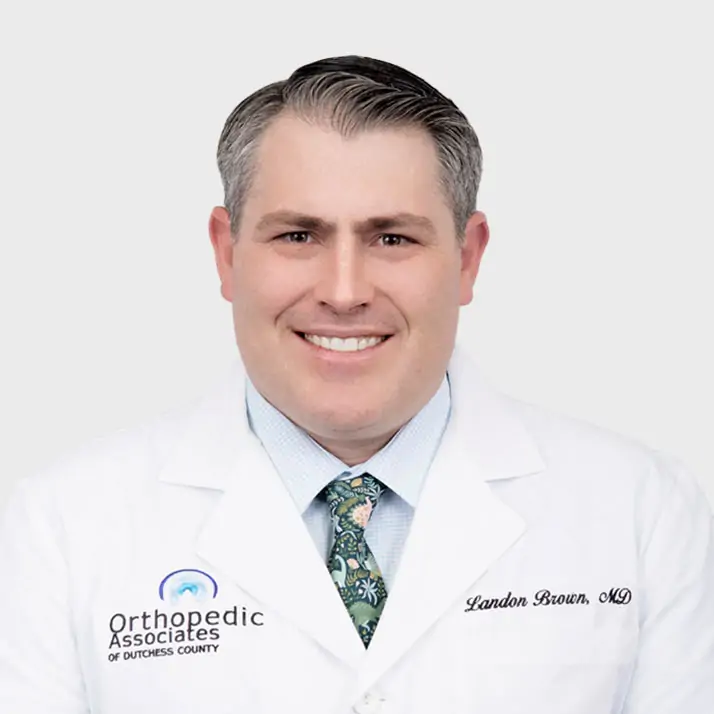Where It Hurts: My Knee
Your knee joint provides the strength that helps you walk, run, squat, jump, and turn. But the muscles, tendons, ligaments, and cartilage are all vulnerable to injury. This is especially true for athletes and active people. Knee injuries can happen in an instant, like ACL and meniscus tears. Also, wear and tear to the knee cartilage can take a toll over time. Learn more about conditions that cause knee pain and how the knee experts at Orthopedic Associates of Dutchess County can help.
Common Knee Injuries and Conditions
We see people with all types of knee pain. The most common injuries and conditions we treat are:
- ACL injuries: Your anterior cruciate ligament connects your shinbone to your thighbone. With a sudden or severe twist, it can tear. This can cause a popping sensation, along with severe pain and swelling. ACL tears usually need reconstructive surgery.
- Arthritis: Osteoarthritis (wear and tear arthritis) is one of the biggest causes of knee pain, most common in people age 50+. However, you’re more at risk for developing arthritis if you’ve had a prior knee injury or have a family history of knee arthritis. As the cartilage wears away, it causes pain, joint stiffness, swelling, and loss of range of motion.
- Kneecap pain (runner’s knee): Also called patellofemoral pain syndrome, this is pain in the front of your knee, behind the kneecap. It hurts when you squat, kneel, or bend your knee, especially when descending stairs or walking downhill. Runners sometimes develop this from repetitive motion, but damaged cartilage or a hit to your knee can also cause it.
- MCL injuries: Your medial collateral ligament runs along the inside of your knee. A blow on the outside of the knee can injure your MCL, causing tenderness and pain. Mild MCL sprains and tears often don’t need surgery while more severe sprains may require surgery.
- Meniscus injuries: Your meniscus is a wedge-shaped, rubbery cushion in your knee. Like any cartilage, it can tear. This can happen because of a sudden or severe twist of the knee or from wear and tear and arthritis.
- PCL tears: Your posterior cruciate ligament runs down the back of your knee. Like your other knee ligaments, it’s vulnerable to injury (especially for athletes). A tear causes pain, swelling, and trouble walking, and sometimes needs surgery.
- Sprains and strains: The soft tissues of your knees (muscles, tendons, and ligaments) can get strained or overstretched. This usually happens because of a fall or other sudden movement. A sprain or a strain can cause loss of mobility, but usually gets better with rest.
- Tendinitis: Your patellar tendon runs from the bottom of your kneecap to your shinbone. With overuse, such as lots of running and jumping, the tendon can get irritated and inflamed. It often causes a dull pain at the top of the shinbone.
We see people with all types of knee pain. The most common injuries and conditions we treat are:
- ACL injuries: Your anterior cruciate ligament connects your shinbone to your thighbone. With a sudden or severe twist, it can tear. This can cause a popping sensation, along with severe pain and swelling. ACL tears usually need reconstructive surgery.
- Arthritis: Osteoarthritis (wear and tear arthritis) is one of the biggest causes of knee pain, most common in people age 50+. However, you’re more at risk for developing arthritis if you’ve had a prior knee injury or have a family history of knee arthritis. As the cartilage wears away, it causes pain, joint stiffness, swelling, and loss of range of motion.
- Kneecap pain (runner’s knee): Also called patellofemoral pain syndrome, this is pain in the front of your knee, behind the kneecap. It hurts when you squat, kneel, or bend your knee, especially when descending stairs or walking downhill. Runners sometimes develop this from repetitive motion, but damaged cartilage or a hit to your knee can also cause it.
- MCL injuries: Your medial collateral ligament runs along the inside of your knee. A blow on the outside of the knee can injure your MCL, causing tenderness and pain. Mild MCL sprains and tears often don’t need surgery while more severe sprains may require surgery.
- Meniscus injuries: Your meniscus is a wedge-shaped, rubbery cushion in your knee. Like any cartilage, it can tear. This can happen because of a sudden or severe twist of the knee or from wear and tear and arthritis.
- PCL tears: Your posterior cruciate ligament runs down the back of your knee. Like your other knee ligaments, it’s vulnerable to injury (especially for athletes). A tear causes pain, swelling, and trouble walking, and sometimes needs surgery.
- Sprains and strains: The soft tissues of your knees (muscles, tendons, and ligaments) can get strained or overstretched. This usually happens because of a fall or other sudden movement. A sprain or a strain can cause loss of mobility, but usually gets better with rest.
- Tendinitis: Your patellar tendon runs from the bottom of your kneecap to your shinbone. With overuse, such as lots of running and jumping, the tendon can get irritated and inflamed. It often causes a dull pain at the top of the shinbone.
Physicians

- Sports Medicine
Practicing in:
Poughkeepsie, Rhinebeck, and Kingston
- Trauma and Fracture Care
- Spine
Practicing in:
Poughkeepsie and Hopewell Junction
- Hip and Knee Replacement
Practicing in:
Poughkeepsie and Hopewell Junction
- Sports Medicine
Practicing in:
Poughkeepsie and Hopewell Junction
- Sports Medicine
Practicing in:
New Windsor, Hopewell Junction, and Poughkeepsie
- Sports Medicine
Practicing in:
Poughkeepsie and Hopewell Junction
- Hip and Knee Replacement
Practicing in:
Poughkeepsie and Kingston
- Sports Medicine
Practicing in:
Rhinebeck and Kingston
- Hip and Knee Replacement
- Sports Medicine
- Trauma and Fracture Care
Practicing in:
New Windsor
- Spine
Practicing in:
Poughkeepsie, Hopewell Junction, New Windsor, and Kingston
- Hip and Knee Replacement
- Trauma and Fracture Care
Practicing in:
Poughkeepsie, Rhinebeck, and Kingston
- Sports Medicine
Practicing in:
Rhinebeck and Kingston
- Sports Medicine
Practicing in:
Rhinebeck and Kingston
- Hip and Knee Replacement
Practicing in:
Poughkeepsie, Hopewell Junction, and Rhinebeck
- Primary Care Sports Medicine
- Sports Medicine
Practicing in:
Poughkeepsie and Hopewell Junction


